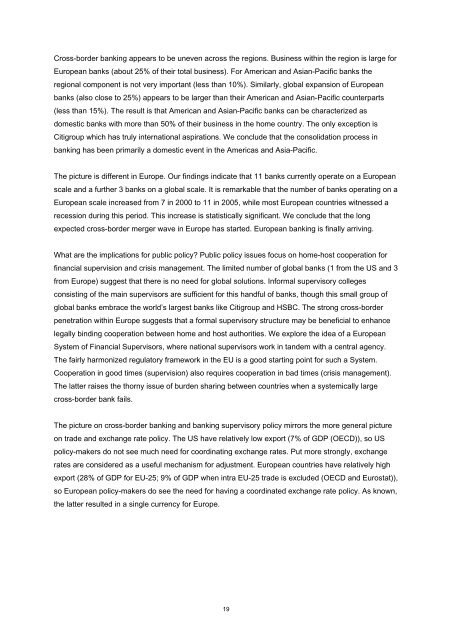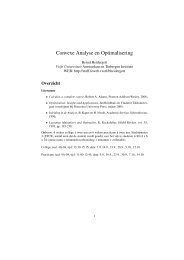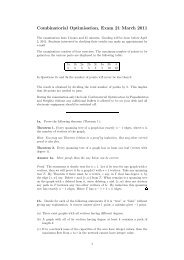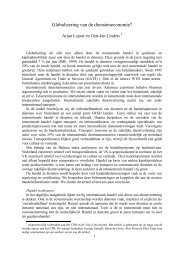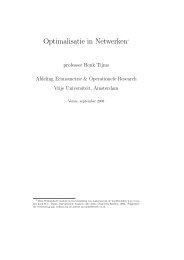Current State of Cross-Border Banking - Vrije Universiteit Amsterdam
Current State of Cross-Border Banking - Vrije Universiteit Amsterdam
Current State of Cross-Border Banking - Vrije Universiteit Amsterdam
You also want an ePaper? Increase the reach of your titles
YUMPU automatically turns print PDFs into web optimized ePapers that Google loves.
<strong>Cross</strong>-border banking appears to be uneven across the regions. Business within the region is large for<br />
European banks (about 25% <strong>of</strong> their total business). For American and Asian-Pacific banks the<br />
regional component is not very important (less than 10%). Similarly, global expansion <strong>of</strong> European<br />
banks (also close to 25%) appears to be larger than their American and Asian-Pacific counterparts<br />
(less than 15%). The result is that American and Asian-Pacific banks can be characterized as<br />
domestic banks with more than 50% <strong>of</strong> their business in the home country. The only exception is<br />
Citigroup which has truly international aspirations. We conclude that the consolidation process in<br />
banking has been primarily a domestic event in the Americas and Asia-Pacific.<br />
The picture is different in Europe. Our findings indicate that 11 banks currently operate on a European<br />
scale and a further 3 banks on a global scale. It is remarkable that the number <strong>of</strong> banks operating on a<br />
European scale increased from 7 in 2000 to 11 in 2005, while most European countries witnessed a<br />
recession during this period. This increase is statistically significant. We conclude that the long<br />
expected cross-border merger wave in Europe has started. European banking is finally arriving.<br />
What are the implications for public policy? Public policy issues focus on home-host cooperation for<br />
financial supervision and crisis management. The limited number <strong>of</strong> global banks (1 from the US and 3<br />
from Europe) suggest that there is no need for global solutions. Informal supervisory colleges<br />
consisting <strong>of</strong> the main supervisors are sufficient for this handful <strong>of</strong> banks, though this small group <strong>of</strong><br />
global banks embrace the world’s largest banks like Citigroup and HSBC. The strong cross-border<br />
penetration within Europe suggests that a formal supervisory structure may be beneficial to enhance<br />
legally binding cooperation between home and host authorities. We explore the idea <strong>of</strong> a European<br />
System <strong>of</strong> Financial Supervisors, where national supervisors work in tandem with a central agency.<br />
The fairly harmonized regulatory framework in the EU is a good starting point for such a System.<br />
Cooperation in good times (supervision) also requires cooperation in bad times (crisis management).<br />
The latter raises the thorny issue <strong>of</strong> burden sharing between countries when a systemically large<br />
cross-border bank fails.<br />
The picture on cross-border banking and banking supervisory policy mirrors the more general picture<br />
on trade and exchange rate policy. The US have relatively low export (7% <strong>of</strong> GDP (OECD)), so US<br />
policy-makers do not see much need for coordinating exchange rates. Put more strongly, exchange<br />
rates are considered as a useful mechanism for adjustment. European countries have relatively high<br />
export (28% <strong>of</strong> GDP for EU-25; 9% <strong>of</strong> GDP when intra EU-25 trade is excluded (OECD and Eurostat)),<br />
so European policy-makers do see the need for having a coordinated exchange rate policy. As known,<br />
the latter resulted in a single currency for Europe.<br />
19


